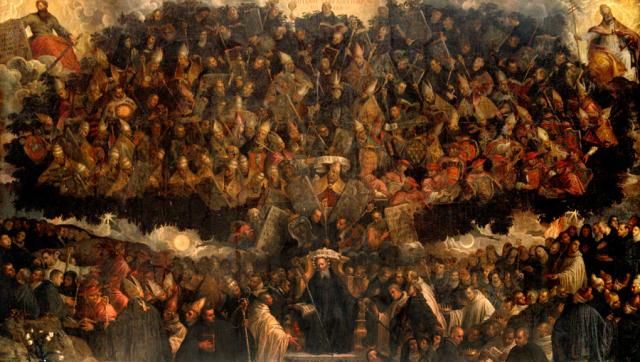Family tree of the benedictine order
San Pietro Museum Complex

Antonio Vassilacchi known as l’Aliense
oil on canvas
1592-1593
This impressive canvas is a grandiose celebration of the Benedictine Order. The work was commissioned by Giacomo di San Felice da Salò, elected abbot of San Pietro in 1590, to the painter of Greek origin Antonio Vassilacchi, called ‘l’Aliense.’ The contract, drawn up in Venice on May 5th 1592, specified delivery of the work by Easter of 1593 for the sum of 700 ducats. Trained in the studio of Paolo Veronese, l’Aliense worked in the Venetian area, and was a disciple of Jacopo Tintoretto, with whom he worked on the construction of San Giorgio Maggiore. It was there, in fact, that the abbot Giacomo spent most of his monastic life.
The iconographic theme is based on the work of the erudite Flemish scholar, Arnold Wion. At that same time, Wion was working on a graphic representation of the genealogy of the Benedictine Order. The result was printed in 1595 under the title Lignum vitae. Benedict, positioned at the center of the lower section of the huge canvas, is shown as the root of a great Cedar of Lebanon, on the sides of which twelve fruits have grown. To the right of the Saint are the representations of the six spiritual congregations (Camaldoli, Vallombrosa, Cistercian, Olivetan, Celestins, Umiliate) as they receive the Rule. On the Saint’s left are the temporal congregations (Knights of Ave, of Calatrava, of Alcantara, of Our Lady of Mercy, of Montesia and of St. Stephen), who are receiving a sword.
The congregations are represented by their founders, as well as the various churchmen who encouraged their growth, all distributed on six concentric hierarchical levels. The great trunk of the cedar has places for Mauro and Placido, who introduced and promoted The Rule in France and Sicily, and are flanked here by Isaiah and Jeremiah. The prophets represent the connection between the birth of the Order and the Old Testament prophecies. The morning star can be picked out in the background, along with the full moon, the sun, a rainbow among the clouds, and fire, symbolic elements recalling the psalm from the Book of Sirach (or Ecclesiasticus) (Ps. 50, 6-12). The full crown of the tree develops into twelve branches, on which, starting from the bottom, we find the popes, the cardinals, martyrs, preachers, confessors and monks.
This unique iconography is enhanced by the monumentality of the canvas, as well as the innovative energy of an extremely theatrical style of painting. This was a genuine innovation for the artistic scene in Perugia at that time.